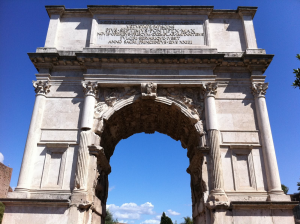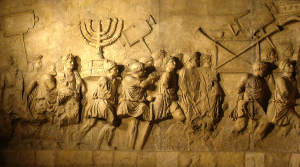By David Cook
The Mäshiach had to come before 70 AD. Let me explain why. In the Tanakh we read prophecies about the suffering, death and resurrection of Yeshua our Lord; the promised Mäshiach. [1] In Daniel chapter 9 we read about important events that were predetermined in heaven for the benefit of the Jewish People;
Seventy weeks are determined for your people and for your holy city, to finish transgression, to make an end of sin, to atone for iniquity, to bring in everlasting righteousness, to seal up the vision and prophecy, and to anoint the most Holy. Daniel 9:24 HSV
The angel Gabriel brought an important communique from heaven to Daniel, foretelling that sin would be atoned for in the future and that everlasting righteousness is available for those who have faith like Abraham. Gabriel prophesied that the Mäshiach would make an end of sin and finish transgression, and be put to death. Yeshua our Savior redeemed us from the debt of our sin with His own blood. The prophet Isaiah wrote extensively of the suffering and crucifixion of God’s Righteous Servant, Yeshua the promised Mäshiach in Isaiah chapter 53. Gabriel gives Daniel these significant points in Daniel chapter 9 verse 24;
- To finish transgression.
- To make an end of sin.
- To atone for iniquity.
- To bring in everlasting righteousness.
- To seal up the vision.
- To seal up prophecy.
- To anoint the most Holy.
Then Gabriel explained that a decree would be made to restore and rebuild Jerusalem;
Therefore know and understand that from the issuing of the decree to restore and rebuild Yerushalayim until the Mäshiach Prince there will be seven ‘sevens’ and sixty-two ‘sevens’. The streets will be rebuilt, and the wall, despite treacherous times. Daniel 9:25 HSV
From the decree to restore and rebuild Jerusalem until the Mashiach comes there will be a certain period of time. The period of time is given in weeks of years, similar to a decade only in seven year periods. There will be seven ‘sevens’ and sixty-two ‘sevens’, for a total of sixty-nine ‘sevens’. Sixty-nine ‘sevens’ or sixty nine weeks of years is equal to 483 years. So after the decree is issued to restore and rebuild Jerusalem there will be 483 years and then the Mäshiach will come.
From the issuing of the decree to restore and rebuild Jerusalem on March 14, 445 BC by Artaxerxes Longimanus until Yeshua arrived and was presented in Jerusalem riding on a donkey as the Messianic King on April 6, 32 AD. This is celebrated by believers of Yeshua the Messiah on Palm Sunday. We discover that when we calculate 69 weeks of years (or 483 years and correct for leap years) it figures out to be 173,880 days to the day. [2]
How is this possible, to announce the coming of the Anointed One, the Lord’s Mäshiach, the King of Zion; almost five centuries before the historical event transpires in precise detail? The Tanakh is an amazing collection of books, our awesome God orchestrated it. YHVH our Elohim is omniscient, the future is as clear to Him as the present and the past; He knows the beginning from the end.
After sixty-two ‘sevens’ the Mäshiach will be put to death, and will have nothing. The people of the prince that will come, will destroy the city and the temple. The end will come with a flood. War and desolation are determined until the end. Daniel 9:26 HSV
So after the sixty-two ‘sevens’ and the before mentioned seven ‘seven’s (483 years) the Mäshiach will be put to death. Then the people of a future prince will come and destroy the city of Jerusalem and the Temple. YHVH Elohim sent Gabriel to tell His people that an Anointed Prince, who is the promised Mäshiach must come, atone for sin and be put to death before the destruction of Jerusalem and the Jewish temple. The destruction of Jerusalem and the second temple occurred in 70 AD, during the siege of Jerusalem; when the Roman legions fought under Titus Vespasian and the Roman army leveled the city. The Siege of Jerusalem in the year 70 AD was the catastrophic and crucial event of the First Jewish-Roman War. [3] The Roman army, led by the future Emperor Titus and Tiberius Julius Alexander second-in-command, along with the enlisted soldier legionnaires in Judaea, conscripted provincial soldiers from Syria, other soldiers from Alexandria and in collaboration they besieged, destroyed and conquered the city of Jerusalem. [4]
Josephus wrote that “Vespasian sent his son Titus [who], came by land into Syria, where he gathered together Roman forces, with a considerable number of auxiliaries from the kings in that neighborhood.” [5] Josephus goes on to give us these details; “Malchus also, the king of Arabia, sent a thousand horseman, besides five thousand footmen, the greatest part of which were archers; so that the whole army, including the auxiliaries sent by the kings, as well as horsemen and footmen, when all were united together, amounted to sixty thousand.” [6]
Publius Cornelius Tacitus was a Roman senator and historian. He wrote extensively on the history, of this period of the Roman empire. Tacitus includes the Roman attack on Jerusalem and gives details of the specific legions and the peoples that comprised the attacking army: “Titus Caesar . . . found in Judaea three legions, the 5th, the 10th, and the 15th . . . To these he added the 12th from Syria, and some men belonging to the 18th and 3rd, who he had withdrawn from Alexandria. This force was accompanied . . . by a strong contingent of Arabs, who hated the Jews with the usual hatred of neighbors.” [7]
The siege ended with the sacking of the city and the destruction of the Second Temple. The destruction of both the first and second temples is mourned each year at the Jewish fast Tisha B’Av. The Arch of Titus, celebrating the Roman sack of Jerusalem and the Temple, still stands in Rome. The Arch of Titus, was built in 82 AD by his younger brother Emperor Domitian to commemorate Emperor Titus’ victories, including in the Siege of Jerusalem in 70 AD.

Photo by J. E. Howard, “The Arch of Titus”; built in 82 AD to commemorate Emperor Titus’ victories; including in the Siege of Jerusalem in 70 AD.
The Jewish People Did Not Recognize the Visitation of the Mäshiach
Tragically, most of the Jewish people did not recognize the time of their visitation by Yeshua the Mäshiach, God’s promised Messianic King. As the Mäshiach King approached Jerusalem, He wept over the city and He gave the reason why the city of Jerusalem and the Second Temple were destroyed as predicted by the angel Gabriel in Daniel 9:26;
41When He approached Jerusalem,
He saw the city and wept over it,
42saying, “If you had known in this day,
even you, the things which make for peace!
But now they have been hidden from your eyes.
43″For the days will come upon you
when your enemies will throw up a barricade against you,
and surround you and hem you in on every side,
44and they will level you to the ground
and your children within you,
and they will not leave in you one stone upon another,
because you did not recognize the time of your visitation.”
Luke 19:41-44 NASB
Both God’s envoy the angel Gabriel and Yeshua the Son of God, the promised Mäshiach prophesied the destruction of the city of Jerusalem and the Temple. In the Bible we see both the severity of God’s judgment and the mercy and love of our Father who is in heaven. Yeshua the Mäshiach explained God’s plan for our redemption and salvation, and how to receive eternal life.
14“As Moses lifted up the serpent in the wilderness,
even so must the Son of Man be lifted up;
15so that whoever believes will in Him have eternal life.
16“For God so loved the world,
that He gave His only begotten Son,
that whoever believes in Him shall not perish, but have eternal life.
17“For God did not send the Son into the world to judge the world,
but that the world might be saved through Him.
18“He who believes in Him is not judged;
he who does not believe has been judged already,
because he has not believed
in the name of the only begotten Son of God.
John 3:14-18 NASB
In the fullness of times, Mäshiach did come and was presented as King in Jerusalem. In the Gospel of John we read how God blesses all those who believe in and receive His Son, Yeshua the promised Mäshiach.
11He came to His own,
and those who were His own did not receive Him.
12But as many as received Him,
to them He gave the right to become children of God,
even to those who believe in His name,
13who were born, not of blood nor of the will of the flesh
nor of the will of man, but of God.
John 1:11-13 NASB
In the book of Daniel 9:26 we read how God sent the angel Gabriel to Daniel in response to his fasting, repentance and contrite prayer to the God of Abraham, Isaac and Jacob. Gabriel told Daniel that the Mäshiach will come and be put to death before the destruction of the Jewish Temple and the city of Jerusalem. We know from history that the siege of Jerusalem by Emperor Titus happened in 70 AD; and this is when the temple and the city of Jerusalem were destroyed. So the Mäshiach had to come before 70 AD. Why then are so many Jewish people still looking for the coming of the Mäshiach?
Is it because they put more faith in the oral traditions of the Talmud taught to them by the rabbinic community; rather than the Word of YHVH Elohim in the Tankh?
[1] Suffering of the Mäshiach, Isaiah chapter 53, Psalm 22:1-24; death of the Mäshiach in Daniel 9:26, Isaiah 53:8-9, resurrection of the Mäshiach Psalm 16:10, Isaiah 53:10-12.
[2] Missler, Chuck, “Daniel’s 70 Weeks”, Koinonia House, 2004. (Also, the recording of “Expositional Commentary on Daniel”)
[3] Siege of Jerusalem in 70 AD, http://en.wikipedia.org/wiki/Siege_of_Jerusalem_(70)
[4] Richardson, Joel, “Mideast Beast”, chapter 7, The People of the Prince to Come; page 91-97, WND Books, 2012.
[5] Flavius Josephus, “The Complete Works of Josephus”, The Wars of the Jews or The History of the Destruction of Jeruselum, bk 3, chap. 1, par. 3.
[6] Ibid, chap. 4, par. 2.
[7] Tacitus, “The History”, New Ed ed., bk. 5.1, ed. Moses Hadas; transs. Alfred Church and William Brodribb (New York: Modern Library, 2003).
Copyright © 2013 by David M. Cook, all rights reserved.


well written. I appreciate your writing.
thank you m.j. !